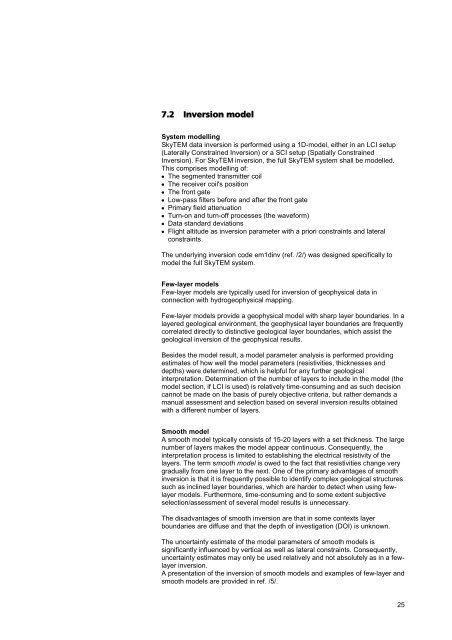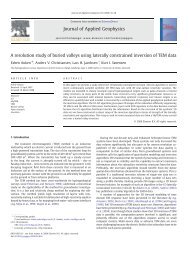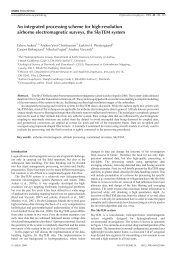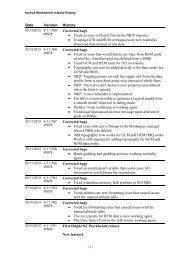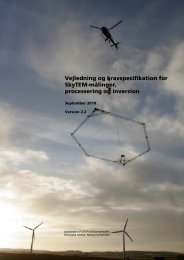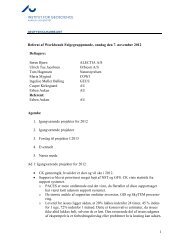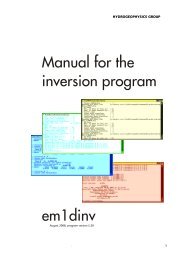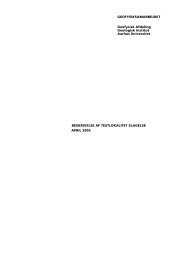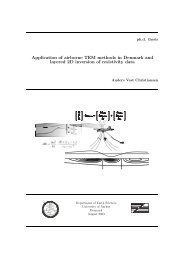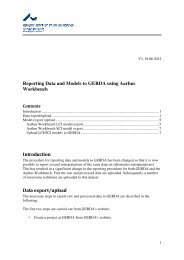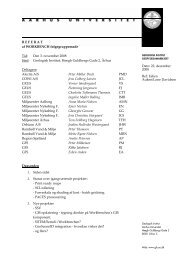guideline and standards for skytem measurements, processing and ...
guideline and standards for skytem measurements, processing and ...
guideline and standards for skytem measurements, processing and ...
You also want an ePaper? Increase the reach of your titles
YUMPU automatically turns print PDFs into web optimized ePapers that Google loves.
7.2 Inversion model<br />
System modelling<br />
SkyTEM data inversion is per<strong>for</strong>med using a 1D-model, either in an LCI setup<br />
(Laterally Constrained Inversion) or a SCI setup (Spatially Constrained<br />
Inversion). For SkyTEM inversion, the full SkyTEM system shall be modelled.<br />
This comprises modelling of:<br />
The segmented transmitter coil<br />
The receiver coil's position<br />
The front gate<br />
Low-pass filters be<strong>for</strong>e <strong>and</strong> after the front gate<br />
Primary field attenuation<br />
Turn-on <strong>and</strong> turn-off processes (the wave<strong>for</strong>m)<br />
Data st<strong>and</strong>ard deviations<br />
Flight altitude as inversion parameter with a priori constraints <strong>and</strong> lateral<br />
constraints.<br />
The underlying inversion code em1dinv (ref. /2/) was designed specifically to<br />
model the full SkyTEM system.<br />
Few-layer models<br />
Few-layer models are typically used <strong>for</strong> inversion of geophysical data in<br />
connection with hydrogeophysical mapping.<br />
Few-layer models provide a geophysical model with sharp layer boundaries. In a<br />
layered geological environment, the geophysical layer boundaries are frequently<br />
correlated directly to distinctive geological layer boundaries, which assist the<br />
geological inversion of the geophysical results.<br />
Besides the model result, a model parameter analysis is per<strong>for</strong>med providing<br />
estimates of how well the model parameters (resistivities, thicknesses <strong>and</strong><br />
depths) were determined, which is helpful <strong>for</strong> any further geological<br />
interpretation. Determination of the number of layers to include in the model (the<br />
model section, if LCI is used) is relatively time-consuming <strong>and</strong> as such decision<br />
cannot be made on the basis of purely objective criteria, but rather dem<strong>and</strong>s a<br />
manual assessment <strong>and</strong> selection based on several inversion results obtained<br />
with a different number of layers.<br />
Smooth model<br />
A smooth model typically consists of 15-20 layers with a set thickness. The large<br />
number of layers makes the model appear continuous. Consequently, the<br />
interpretation process is limited to establishing the electrical resistivity of the<br />
layers. The term smooth model is owed to the fact that resistivities change very<br />
gradually from one layer to the next. One of the primary advantages of smooth<br />
inversion is that it is frequently possible to identify complex geological structures<br />
such as inclined layer boundaries, which are harder to detect when using fewlayer<br />
models. Furthermore, time-consuming <strong>and</strong> to some extent subjective<br />
selection/assessment of several model results is unnecessary.<br />
The disadvantages of smooth inversion are that in some contexts layer<br />
boundaries are diffuse <strong>and</strong> that the depth of investigation (DOI) is unknown.<br />
The uncertainty estimate of the model parameters of smooth models is<br />
significantly influenced by vertical as well as lateral constraints. Consequently,<br />
uncertainty estimates may only be used relatively <strong>and</strong> not absolutely as in a fewlayer<br />
inversion.<br />
A presentation of the inversion of smooth models <strong>and</strong> examples of few-layer <strong>and</strong><br />
smooth models are provided in ref. /5/.<br />
25


